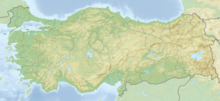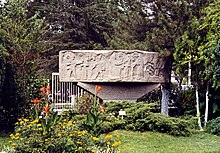Fıraktın rock relief
The Hittite rock relief of Fıraktın (also Fraktın ) is located about 50 km south of Kayseri in the province of the same name in southeast Turkey. It is located by the village of Fıraktın on the banks of the Enzel Dere, a tributary of the Zamantı Irmağı. In Strabo the place is called Dastarkon .
Coordinates: 38 ° 16 ′ 18 ″ N , 35 ° 37 ′ 54 ″ E
location
The rock relief lies in a high valley that opens east of Develi between the Erciyes Dağı and the Aladağlar to the east. In historical times, an important road connection to Cilicia and on to Syria ran through this valley , over the year-round pass Gezbeli and Küçük Gezbeli. Five reliefs from the time of the Hittite Empire were found there between 1880 and 1939, an accumulation that is unique in Anatolia. They are the reliefs of Hanyeri , Imamkulu , Taşçı A and B and Fıraktın.
construction
The relief is about 1.3 by 3.2 meters and dates from the 13th century BC. BC, i.e. from the time of the Hittite empire . It is oriented to the northwest, to the Erciyes Dağı, which, like all mountains, was deified in Hittite times. It consists of three parts. The left section shows Great King Ḫattušili III. (right), who sacrifices to the weather god by pouring a liquid from a kind of jug into a vessel on the floor. Between the two there is an altar-like structure, on it a conical object with grooves, possibly a sacrificial bread. God and King are both dressed in the pointed cap, which actually denotes a god. This suggests that the image may have been created after Ḫattušili's death during the reign of his son and successor Tudḫaliya IV , as the Hittite kings became gods after their death. The weather god holds a crook in his hands. In front of the heads of the people there are hieroglyphic signs that designate the individual depicted. In the middle scene you can see his wife, Great Queen ( Tawananna ) Puduḫepa (right), who offers a libation sacrifice to the sun goddess Ḫepat . Here, too, an altar can be seen between the figures, on which a bird or a bird-shaped vessel stands. The representations become coarser towards the right; the work may not have been completed. In the third part, large-format Luwian hieroglyphs are carved out. They continue the name of the queen, which began in front of the head, with "daughter of the land of Kizzuwatna , loved by the god" .
A concrete copy of the relief can be viewed in the Kayseri Museum, and a plaster cast in the Pergamon Museum in Berlin. A Mycenaean vase has been unearthed nearby, probably brought here from Cilicia.
literature
- Kay Kohlmeyer : Rock paintings from the Hittite Empire. In: Acta Praehistorica et Archaeologica 15 (1983) pp. 67-74.
- Eberhard P. Rossner: The Hittite rock reliefs in Turkey. 2nd edition, 1988, ISBN 3-924390-02-9 .
- Horst Ehringhaus : gods, rulers, inscriptions. The rock reliefs of the Hittite Empire in Turkey. Zabern, Mainz 2005, ISBN 3-8053-3469-9 , pp. 59-65.
Web links
Individual evidence
- ↑ a b Horst Ehringhaus: Gods, rulers, inscriptions. The rock reliefs of the Hittite Empire in Turkey. Zabern, Mainz 2005, pp. 59-65.
- ^ Albrecht Goetze: Cultural history of Asia Minor . CH Beck, Munich 1974, p. 182. ISBN 9783406013515 at GoogleBooks



